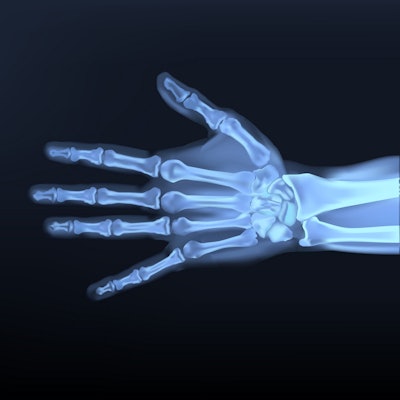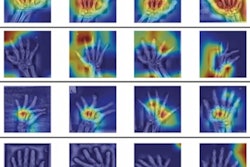
Hand x-rays appear as useful as standard wrist x-rays for diagnosing carpal bone injuries and could reduce costs and radiation exposure to injured patients, according to a study published May 27 in the Journal of Hand Surgery.
A group of orthopedic surgeons led by Dr. Heather Taillac at the University of Florida in Gainesville reported that angles among carpal bones can be measured as accurately on a standard series of hand radiographs compared to wrist radiographs.
"Understanding the accuracy of these measurements on hand radiographs versus wrist radiographs could facilitate the assessment of carpal stability without obtaining additional radiographic views," the group wrote.
Carpal bones connect the radial and ulnar bones of the forearm to the bones of the hand. There are eight carpal bones. Measuring angles among these bones after injuries is key for planning surgical treatments, the authors explained.
Traditionally, these angles are measured using standard wrist radiographs, yet patient positioning is difficult and often reduces their reliability, which can require additional imaging and more radiation exposure to patients, the authors noted. Moreover, the accuracy of these measurements has not been determined based on x-rays of the hand, they added.
To that end, the researchers gathered images from 40 patients who had undergone both hand and wrist x-rays. Three orthopedic surgeons used both sets to measure five carpal bone angles: the radioscaphoid, radiolunate, scapholunate, capitolunate, and radiocapitate.
The readers had moderate, good, or excellent agreement for all measurements for both hand and wrist radiographs. Specifically, interrater agreement was superior in favor of hand radiographs for the radiocapitate and capitolunate angles.
| Reader agreements for measuring carpal angles on hand and wrist x-rays | ||
| Wrist x-rays | Hand x-rays | |
| Radiocapitate angle | 54% | 74% |
| Capitolunate angle | 65% | 82% |
| Scapholunate angle | 76% | 75% |
| Radiolunate angle | 93% | 91% |
| Radioscaphoid angle | 83% | 78% |
In addition, the mean differences in measurements on hand versus wrist radiographs were less than 5° for all angles, which is within a reported 5.2° standard deviation.
"This study demonstrated high interrater and intrarater reliability for all carpal angle measurements on both hand and wrist radiographs," the researchers wrote.
Part of the difficulty in obtaining standardized lateral wrist radiographs is that positioning is based on external landmarks that do not correlate precisely with radiographic parameters used to assess wrist rotation, the authors wrote. In this regard, easier-to-obtain hand x-rays may offer an alternative in addition to reducing the need for additional imaging due to improper patient positioning, they suggested.
"In addition to minimizing radiation exposure and cost in the clinical setting, this could increase opportunities for retrospective studies in which the only available lateral radiographs are those of the hand," the group concluded.




















